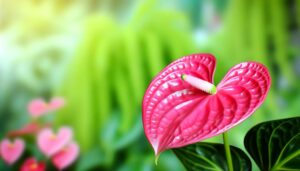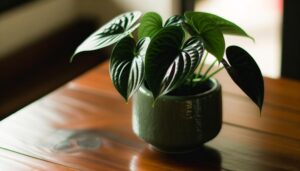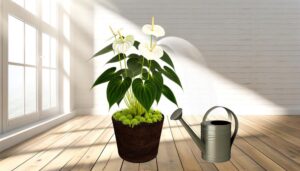What Is the Hawaiian Anthurium Society?
The Hawaiian Anthurium Society, founded in 1985, focuses on the genetic diversity, taxonomy, and horticultural importance of Anthurium species. The Society emphasizes phytopathology, environmental adaptability, and advanced cultivation techniques, including tissue culture.
Members benefit from access to specialized journals, peer-reviewed publications, and a robust network of experts. Educational initiatives include workshops and conferences on the latest advancements in anthurium cultivation and research.
Conservation efforts involve cultivating rare species and protecting natural habitats through genetic studies. Collaborations with botanical gardens and universities further enhance their research endeavors.
Discover more about their all-encompassing approach to Anthurium conservation and innovation.

Key Takeaways
- Founded in 1985, the Hawaiian Anthurium Society focuses on genetic diversity, horticultural importance, and conservation of anthuriums.
- Membership benefits include access to specialized journals, advanced horticultural techniques, and a network for collaboration with experts.
- The Society organizes workshops, seminars, and conferences to educate members on the latest advancements in anthurium cultivation and research.
- Plant shows and exhibitions showcase horticultural excellence, genetic diversity, and advancements in hybridization and crossbreeding techniques.
- Conservation efforts include cultivating anthuriums in controlled environments, protecting natural habitats, and propagating rare species through tissue culture.
History and Founding
Founded in 1985, the Hawaiian Anthurium Society was established to promote the cultivation, study, and hybridization of Anthurium species, with a focus on preserving the genetic diversity and horticultural importance of these tropical plants.
The society emerged in response to the increasing interest in Anthurium genetics and propagation techniques. It provided a structured platform for botanists, horticulturists, and enthusiasts to exchange knowledge and collaborate on research.
Early efforts concentrated on identifying and cataloging native and hybrid species, emphasizing the significance of conservation and sustainable cultivation practices.
Through symposia, academic publications, and collaborative projects, the society has greatly contributed to advancements in Anthurium taxonomy, phytopathology, and environmental adaptability, ensuring the resilience and continued appreciation of these ornamental plants.
Membership Benefits
Membership in the Hawaiian Anthurium Society offers access to exclusive resources such as specialized journals, advanced horticultural techniques, and a network of experts dedicated to the scientific study and propagation of Anthurium species.
Members benefit from peer-reviewed publications that provide cutting-edge research on Anthurium genetics, pathology, and breeding methodologies. The society's repository of advanced horticultural techniques includes tissue culture protocols, pest management strategies, and optimized fertilization regimens.
Additionally, the network facilitates collaboration, enabling members to engage with leading botanists, horticulturists, and researchers. This professional community offers opportunities for sharing best practices, troubleshooting cultivation challenges, and contributing to collective knowledge.
Membership guarantees access to a wealth of scientific data and practical insights, fostering enhanced cultivation and preservation of Anthurium species.
Educational Events
In addition to providing access to advanced horticultural techniques and a network of experts, the Hawaiian Anthurium Society organizes regular educational events that offer in-depth workshops, seminars, and conferences focused on the latest advancements in Anthurium cultivation and research.
These events feature detailed presentations on topics such as tissue culture propagation, pest and disease management, and genetic modification techniques. Participants gain hands-on experience with cutting-edge methodologies and detailed insights into optimizing growing conditions for various Anthurium species.
Workshops often include live demonstrations of laboratory techniques, while seminars provide updates on recent scientific studies. These educational opportunities are designed to enhance the theoretical and practical knowledge of members, ensuring they remain at the forefront of Anthurium horticulture.
Plant Shows
The Hawaiian Anthurium Society's plant shows are pivotal events that spotlight the horticultural excellence and genetic diversity of anthuriums.
These exhibitions feature meticulously curated displays, showcasing award-winning cultivars distinguished by their unique morphological traits and superior phenotypic qualities.
Attendees have the opportunity to observe firsthand the advancements in hybridization and the horticultural practices that contribute to the development of these exemplary anthurium specimens.
Exhibition Event Highlights
Showcasing a diverse range of Anthurium varieties, the recent exhibition featured thoughtfully curated plant displays that highlighted advanced crossbreeding techniques and innovative horticultural practices.
The event provided a detailed look at phenotypic variations, focusing on traits such as spathe coloring, spadix structure, and foliage designs. Exhibitors utilized controlled environment agriculture (CEA) systems to demonstrate ideal growing conditions, emphasizing factors like humidity, light brightness, and nutrient delivery.
Detailed informational panels explained the genetic modifications undertaken to enhance disease resistance and improve aesthetic characteristics. Additionally, cutting-edge propagation methods, including tissue culture and somatic embryogenesis, were prominently displayed, offering attendees insights into sustainable cultivation processes.
The exhibition served as a thorough educational platform for both new and seasoned Anthurium enthusiasts.
Award-Winning Anthuriums
Numerous exceptional Anthurium cultivars garnered top honors at the recent plant shows, exemplifying superior spathe chromatics, innovative hybridization techniques, and resilient phenotypic traits. These award-winning specimens were evaluated on criteria including spathe vibrancy, inflorescence structure, and foliage integrity. The meticulous breeding methodologies employed have resulted in robust, aesthetically pleasing plants that thrive under diverse environmental conditions. Presented below is a detailed table highlighting the top award recipients:
| Cultivar Name | Award Received |
|---|---|
| Anthurium 'Tropic Fire' | Best in Show |
| Anthurium 'Lava Glow' | Superior Hybridization |
| Anthurium 'Emerald Queen' | Best Phenotypic Resilience |
These cultivars underscore the advancements in Anthurium cultivation, contributing notably to horticultural sciences and the enrichment of botanical collections globally.
Conservation Efforts
Implementing advanced cultivation in controlled environments and protecting natural habitats methodologies, the Hawaiian Anthurium Society collaborates with botanical gardens and research institutions to safeguard endangered native anthurium species. These efforts are essential for maintaining genetic diversity and protecting these plants from extinction.
Cultivation in controlled environments includes the growth of anthuriums in controlled settings such as greenhouses, while efforts to protect natural habitats focus on preserving their original environments. The society employs tissue culture techniques to propagate rare species and conducts genetic studies to enhance understanding of anthurium biodiversity.
- Cultivation in controlled environments: Growing in controlled settings.
- Protecting natural habitats: Preserving original environments.
- Tissue culture: Propagating rare species.
- Genetic studies: Enhancing biodiversity understanding.
- Collaboration: Working with botanical gardens and research institutions.
These strategic initiatives ensure the longevity and resilience of Hawaiian anthuriums.
Global Outreach
The Hawaiian Anthurium Society's global outreach initiatives encompass the establishment of international partnerships and the facilitation of cultural exchange programs. Through these collaborative efforts, the Society engages in cross-border scientific research projects, sharing genetic resources, and horticultural techniques.
These initiatives foster a reciprocal exchange of knowledge, promoting biodiversity conservation and enhancing the global understanding of anthurium cultivation practices.
International Partnerships
Establishing international partnerships has been crucial in enhancing the Hawaiian Anthurium Society's research capabilities and global biodiversity conservation efforts. These collaborations facilitate the exchange of scientific data, germplasm resources, and advanced horticultural techniques, fostering an environment of mutual academic and practical growth.
By engaging with botanical institutions worldwide, the Society gains access to diverse genetic pools, which are crucial for breeding programs aimed at disease resistance and phenotypic diversity.
Collaborative research initiatives with leading botanical gardens and universities.
Germplasm exchange programs to enhance genetic diversity.
Joint publication ventures in peer-reviewed scientific journals.
International symposiums and conferences for knowledge dissemination.
Cooperative grant proposals to secure funding for conservation projects.
These strategic alliances guarantee the Society remains at the forefront of anthurium research and conservation.
Cultural Exchange Programs
Fostering global outreach through cultural exchange programs enables the Hawaiian Anthurium Society to integrate diverse horticultural practices and traditional knowledge, thereby enriching its conservation strategies and educational initiatives.
These programs facilitate the exchange of advanced cultivation techniques, pest control methodologies, and sustainable farming practices between local growers and international experts. By engaging in reciprocal visits and collaborative research, the Society enhances its genetic diversity studies and propagation protocols.
Additionally, these exchanges provide insights into ethnobotanical applications, promoting a deeper understanding of anthurium species within various cultural contexts. The resulting synergies not only bolster the Society's scientific endeavors but also contribute to the global conservation of anthurium biodiversity, ensuring long-term viability and resilience of these crucial ornamental plants.
Conclusion
The Hawaiian Anthurium Society, with its intricate history, exclusive membership perks, educational programming, and conservation initiatives, epitomizes the botanical elite's dedication to Anthurium cultivation.
Its plant shows and global outreach initiatives are commendable, ensuring that this floral aristocracy flourishes both locally and internationally.
Ironically, while pursuing conservation, the society's activities inadvertently highlight humanity's paradoxical obsession with preserving and showcasing nature's rarities—often to the detriment of the very ecosystems they aim to protect.






